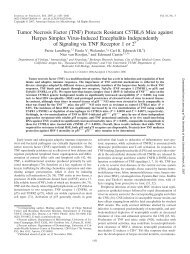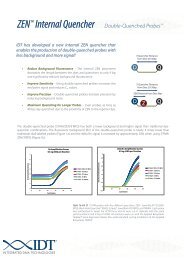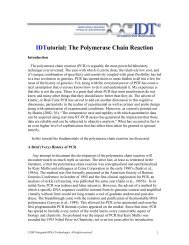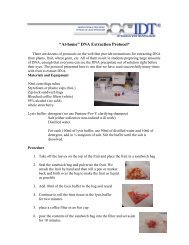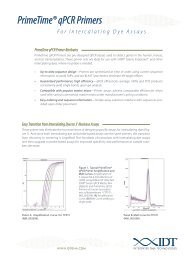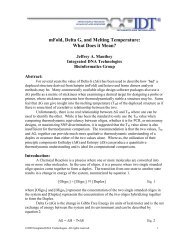products - Integrated DNA Technologies
products - Integrated DNA Technologies
products - Integrated DNA Technologies
Create successful ePaper yourself
Turn your PDF publications into a flip-book with our unique Google optimized e-Paper software.
INTEGRATED<strong>DNA</strong>TECHNOLOGIESPRODUCTSAPPENDIXMolar Extinction CoefficientOptical absorbance at 260 nm is routinely used to measure the concentration of nucleic acids present in a solution. Approximate conversionfactors estimate that duplex <strong>DNA</strong> is about 50 µg/OD 260, single-stranded RNA is approximately 40 µg/OD 260, and single-stranded <strong>DNA</strong> isapproximately 33 µg/OD 260. While this is true for randomized sequences, these conversion factors are less accurate for short oligonucleotidesand repeating sequences. Since the absorbance of each base is different, base composition and sequence context influence the absorbance.For example, 1.0 OD 260of d(CCCCCCCCCCCC) (homopolymeric deoxycytidine) has a mass of 39 µg while 1.0 OD 260of d(AAAAAAAAAAAA)(homopolymeric deoxyadenosine) has a mass of 25 µg. The extinction coefficient (ε 260) describes the relationship between concentrationand UV absorbance and can be calculated for any sequence. Greatest accuracy is therefore achieved when the exact value of ε 260iscalculated for each oligo. Further, it is possible to take into account the presence of modified groups, such as fluorescent dyes, which havesignificant absorbance at 260 nm.The molar extinction coefficient is a physical constant that is unique for each sequence and describes the amount of absorbance at 260 nm(A 260) of 1 mole/L <strong>DNA</strong> solution measured in 1 cm path-length cuvette. This definition is derived from the Beer-Lambert law,A = log(I O/ I) = ε * c * pwhere A is the absorbance, I Oand I are, respectively, the intensities of incident and transmitted light, c is the molar concentration of anoligonucleotide (mole/L), p is the length of the light path through the sample (cm), and ε is the molecule molar extinction coefficient (L/(mole .cm)). The ε 260value of an oligonucleotide is calculated from the following equation (Cantor,C.R. et al., Biopolymers, 9, 1059-1077.,Cavaluzzi,M.J. and Borer,P.N. Nucleic Acids Res., 32, e13),ε 260= 2x (Σε Nearest-Neighbor ) - Σε Individual + Σε ModificationN-1 N-1 N1 2 1where ε Nearest-Neighboris the nearest neighbor coefficient for a pair of bases, ε Individualis the coefficient for an individual base, and N is the lengthof the oligonucleotide.Molecular Weight (Anhydrous)Molecular weight (MW) is the sum of the atomic masses of the constituent atoms for 1 nmole of oligonucleotide. The anhydrous molecularweight represents the pure oligo free of any of the counter ions or water molecules that are normally weakly bound to an oligo aftersynthesis. This calculation gives the molecular weight as measured by mass spectrometry.Molecular weight of an oligomer is a sum of the weights of individual bases and chemical modifications. Oligos are typically synthesizedwithout a 5’-phosphate group, which must be subtracted.where PO 2H = 63.980 and H 2= 2.016Anhydrous MW = Σ Individual Base MW+ Σ Individual Mod MW- PO 2H + H 2Molecular weights of <strong>DNA</strong> bases:dA 313.2dC 289.2dG 329.2dT 304.2dU 290.2dI 314.2RNA bases: The molecular weight of an RNA nucleotide is the weight of a <strong>DNA</strong> nucleotide + 15.999, accounting for the additional oxygenatom present (Example: rA is dA (313.209) + 15.999 = 329.208). When determining the weight of uracil (rU), start with dU and not thymine(dT).2’-O-Methyl bases: The molecular weight of a 2’-O-Methyl RNA nucleotide is the weight of a <strong>DNA</strong> nucleotide + 30.026, accounting for theadditional methoxy group (-OCH 3) present (For example: mA is dA (313.209) + 30.026 = 343.235). When determining the weight of uracil(mU), start with dU and not thymine (dT).©2008 <strong>Integrated</strong> <strong>DNA</strong> <strong>Technologies</strong> www.idtdna.com91



